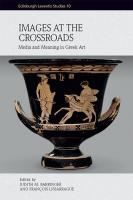
Edinburgh (2022) h/b 582pp £100.00 (ISBN 9781474487368)
Since the 1990s, the ‘visual turn’ has redefined ways of seeing classical Greek art, challenging definitions and pushing the boundaries of research to include ‘viewer perception of images, as well as images of images, the transformation of images, and their reuse, reference, and inference in every respect’. At the same time the importance of the contexts in which artworks were not only commissioned, created and circulated in antiquity but discovered in the modern age has become increasingly apparent. As the fluidity of ancient art becomes clearer, old assumptions are being challenged and intriguing new discoveries made—and some of these form the basis of this important new collection by an international cast of leading proponents. With its roots in the tenth biennial A. G. Leventis Conference held at the University of Edinburgh in 2017, the collection covers a lot of ground from the theoretical to the archaeological and art historical.
Divided into six sections (‘Making Meaning: How Do Images Work?’; ‘Interpretation and Perception’; ‘Reflections of the City and its Craftsmen’; ‘Constructions of Myth Through Images’; ‘Clay and Stone: Material Matters’; ‘Honouring the Dead’), the sheer volume of material is too great for detailed consideration here, but representative of its breadth of content are: M. Menichetti analyzing the Alexander Mosaic to uncover what it shows about how Greeks commemorated victory; D. Williams drawing on vase paintings to form a witty and intriguing visual reconstruction of ancient Athens; M. Meyer discussing how the sudden eruption of images of the Gigantomachy may suggest that the myth was invented for the first Great Panathenaea of 566 BC; T. Hölscher considering the status of Athenian artists and artisans, who were occasionally wealthy (and possibly as good-looking as some representations suggest); M. D. Stansbury-O’Donnell on how a cross-fertilization of Etruscan, South Italian and Athenian ideas influenced images of Eos with Memnon or Tithonus (to which each culture would have responded differently); N. Dietrich debating the relationship between Archaic kouroi and sculpted stelae as grave markers and how they interacted with both the living viewer and the dead (who may not always have been genial); and J. Barringer positing that between 470 and 429 BC wood replaced stone as the medium used for funerary stelae. Then there is S. Schmidt’s discussion of representations of the Kaberoi, and what they suggest about drunkenness and laughter both at Boeotian initiation ceremonies and in Athenian comedy; A. Muller’s consideration of Archaic figurative terracottas found in sanctuaries (where they represent the dedicator, not the dedicatee); and L. Giuliani’s suggestion that the Chigi Vase was intended to prompt discussion at symposia about the values of the Greek elite. And those are but 10 of the 21 collected papers.
Although the few chapters focussing on theory may appeal only to specialists, there is much that interested readers will find stimulating, while the physical delight of handling this well-produced book with 120 black-and-white and 170 colour photographs will add to their enthusiasm (even if they find, as this reviewer did, that the size of some images means that details mentioned in the text are not always discernible). Including useful footnotes, a comprehensive bibliography, an index of objects and a subject index, it is a volume of which all involved should be proud, and which will stand as a worthy memorial to one of its two editors, François Lissarrague, who died suddenly and unexpectedly while it was in press. Academic libraries should not be without a copy, and general readers cannot help but be infected by the vitality, enthusiasm and excitement which most of its contributors convey.
David Stuttard
